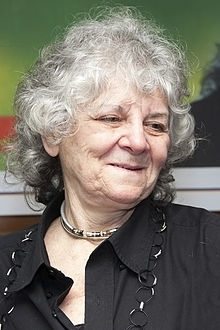Ada Yonath

Ada E. Yonath, Hebrew: עדה יונת , (born June 22, 1939) is an Israeli crystallographer. She received the 2009 Nobel Prize in Chemistry together with Thomas A. Steitz and Venkatraman Ramakrishnan for studies of the structure and function of the ribosome.[1]
Early life[change | change source]
She was born in the Geula quarter of Jerusalem. Her father was a rabbi. Yonath and her family moved to Tel Aviv after her father died.
Education[change | change source]
She received her bachelor's degree in chemistry in 1962. She received her master's degree in biochemistry in 1964. She got both degrees from the Hebrew University in Jerusalem. She received her Ph.D. in X-Ray Crystallography at the Weizmann Institute of Science in 1968. Yonath made the first protein crystallography lab at the Weizmann Institute. Her work showed the function of ribosomes. Yonath worked at Carnegie-Mellon University and MIT for several years. She stayed as Weizmann Institute for the rest of her career.
Work[change | change source]
Ada Yonath is an Israeli chemist who made pictures of ribosomes using X-ray Crystallography. Ribosomes are the part of cells in the human body that put together proteins. X-ray Crystallography makes pictures of molecules by bunching them into crystals. This method is only used to make models of single atoms. Yonath used this methods to crystallize ribosomes although they are made of many atoms and proteins. This made her work very difficult. She returned to the Weizmann Institute of Science in 1970. She started the first Protein Crystallography lab in Israel. She did research at the Max Planck Institute for Molecular Genetics in Berlin, Germany from 1979 to 1984. She began trying to make ribosomes into crystals in 1970. [1]
Accomplishments[change | change source]
She made the first model of a large ribosome in 1980.
In 2006 she won the Wolf Prize in Chemistry.
She won the 2009 Nobel Prize in Chemistry with Venkatraman Ramakrishnan and Thomas Steitz. This Nobel prize was for her work in making images of ribosomes. She studied Molecular Genetics in Berlin, Germany, before winning the Nobel prize.
Later life[change | change source]
Yonath led a research team at the Max Planck Institute in Hamburg, Germany for 18 years. She also continued research at the Weizmann Institute of Science.[2]
Related pages[change | change source]
References[change | change source]
- ↑ "Ada E. Yonath - Facts". Nobelprize.org.
- ↑ "Yonath, Ada E.." World Book Advanced, World Book, 2017, www.worldbookonline.com/advanced/article?id=ar754092. Accessed 31 Mar. 2017.
